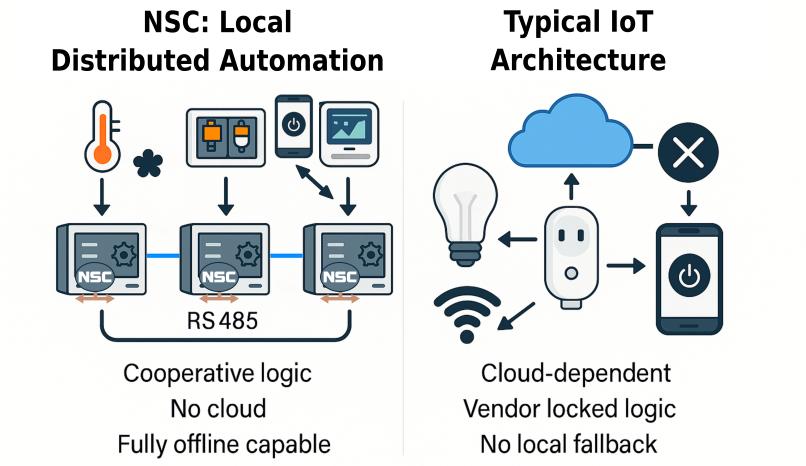NSC vs IoT Devices
Why choose a professional distributed system over cloud-tied smart gadgets?
Beyond Smart Gadgets
While platforms like Tuya*, Shelly*, and Sonoff* offer quick access to remote-controlled outlets and sensors, they come with cloud reliance, limited logic and behavior. The Networked Smart Control (NSC) system provides a radically different approach: a fully autonomous, resilient, and programmable distributed infrastructure for serious automation — from home to industry.
*Brand names are used for illustrative purposes only. The information provided is believed to be accurate but may contain errors or omissions.
Core Philosophy
| NSC System | Typical IoT Devices | |
|---|---|---|
| Architecture | Distributed autonomous nodes with local logic and inter-device cooperation | Centralized logic (cloud, app, or hub-dependent) |
| Programming Model | Event-driven: user-defined logic in visual form or native C | Predefined behaviors, limited customization |
| Independence | Runs offline. Auto-skips unreachable nodes with fallback logic | Partial or total loss of functionality without cloud access |
| Privacy & Control | 100% local. No telemetry. No remote code updates unless explicitly implemented | Cloud-connected, often with data sent to third-party servers |
| Network Type | RS485 fieldbus, or optionally 833MHz radio links | Wi-Fi, Zigbee, Bluetooth — vulnerable to congestion and dropout |
| Customization | Complete: from high-level logic to low-level firmware | Minimal. Vendor-restricted APIs or firmware locking |
| Security | Wired or local-only communication. No external exposure | Internet-facing by default. Often weak credential defaults |
| Long-Term Stability | Designed for 24/7 automation. Thousands of units still operational after 20+ years | Dependent on firmware support and cloud service continuity |
Feature Comparison
| Feature | NSC | IoT Devices |
|---|---|---|
| Visual Logic Programming | ✔ Full visual environment (MaticStudio) | ✖ App-driven presets only |
| Custom Logic & Scripting | ✔ Visual + native C (via SDK) | ✖ Often unsupported or locked |
| Real-Time Local Control | ✔ Deterministic, no latency from network/cloud | ✖ Often cloud-dependent, inconsistent timing |
| Inter-Device Synchronization | ✔ Native distributed RPCs, auto-generated | ✖ Requires cloud routines or manual app grouping |
| Offline Operation | ✔ Fully functional, with automatic degraded-mode behavior | ✖ Often loses functionality when disconnected |
| Scaling Beyond 10 Devices | ✔ Seamless: up to 126 nodes per bus | ✖ Manual pairing, increased complexity |
| SCADA & Display Integration | ✔ Built-in UI generation via Virtual Components | ✖ Requires external platforms or coding |
Which Should You Use?
Choose NSC if:
- You need reliable, long-term automation with local control
- You’re building a critical, custom, or professional-grade system
- You want full freedom: logic, firmware, communication, integration
- You care about privacy, determinism, and scalability
Choose IoT devices if:
- You want quick, plug-and-play automation for a few appliances
- You don’t need much logic or automation beyond “on/off”
- You’re comfortable with cloud dependencies and occasional lag
- You don’t need deep customization or long-term maintainability
👉 You may also want to read how NSC compares with Arduino
👉 Here a summary that compares NSC, Konnex and IoT